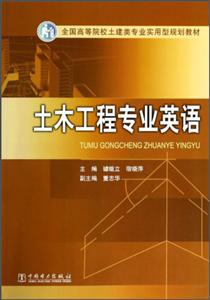
作者:吴轶主编
页数:163页
出版社:武汉大学出版社
出版日期:2015
ISBN:9787307159952
电子书格式:pdf/epub/txt
内容简介
本书选材涉及土木工程概况、土木工程类别、土木工程材料、工程荷载以及作用、结构构件类别、地下工程、桥梁工程、道路工程、工程抗震设计、隔震技术、建筑加固技术等方面, 分为13个单元, 每个单元均由课文、生词组成。涉及工程材料、材料力学、理论力学、混凝土结构设计原理、钢结构设计原理、道路工程、结构抗震设计、建筑加固理论、土力学、基础工程等相关学科知识。
作者简介
吴轶,博士,广州大学教授。2004年获华南理工大学结构工程专业工学博士学位,2005年晋升副教授,2010年晋升教授。长期从事高层建筑结构抗震、结构减震控制及城市防灾减灾方面的教学、科研工作。主持与主要参加10余项国家自然科学基金、省部级及厅局级项目。在Engineering struchures、《工程力学》、《计算力学学报》、《土木工程学报》等刊物上发表40余篇学术论文,出版教材2部,参编教材3部。
目录
1.1 Introduction of Civil Engineering
Section A The Origin of Civil Engineering
Section B What Is a Civil Engineer
1.2 The Importance of Civil Engineering
Section A The Role of Civil Engineering in Society
Section B Historic Civil Engineering Landmarks
References
Chapter 2 Types of Civil Engineering
2.1 Structural Engineering
Section A Introduction of Structural Engineering
Section B Basic Types of Structures
2.2 Bridge Engineering
2.3 Underground Engineering
Section A Introduction of Metropolitan Railway
Section B Introduction of Tunnel Engineering
2.4 Road Engineering
Section A Introduction of Road Engineering
Section B Maintenance of Road Engineering
References
Chapter 3 Materials of Civil Engineering
3.1 Concrete
Section A Introduction of Concrete
Section B Properties of Concrete
3.2 Steel
3.3 Masonry
References
Chapter 4 Loads and Actions in Civil Engineering
4.1 Dead Load and Live Load
4.2 Wind Load and Wind Damage
Section A Introduction of Wind Load
Section B Classification of Wind Load
Section C Horizontal Wind Loads and Roof Wind Loads on Structural Frames
Section D Wind for Components and Wind Damage
4.3 Earthquake Action and Damage
Section A Earthquake Action
Section B Earthquake Damage
4.4 Tsunami Damage to the Structure of Civil Engineering
Section A Tsunami Damage
Section B Tsunami Damage to Buildings
Section C Resistance of Tsunamis for Structures
References
Chapter 5 Members of Civil Engineering
5.1 Horizontal Forced Structural Members
Section A Introduction of Beam
Section B Forces within a Beam
Section C Shear Strength and Parameters
Section D Coupling Beams
Section E Flat Plates
Section F Behavior of Concrete Slabs
Section G Floor Framing Systems
5.2 Vertical Forced Structural Members
Section A Introduction of Column
Section B Increasing Compressive Strength
Section C High-strength Steel in Concrete Columns
Section D Confinement in Reinforced Concrete Columns
Section E Introduction of Concrete Structural Wall
Section F Behavior of Structural Wall
Section G Steel Plate Shear Walls
5.3 Arch
Section A Introduction of Arches
Section B Development of Arch Bridges
5.4 Truss
Section A Introduction of Truss
Section B Analysis of Internal Force
Section C Production and Installation of a Truss
References
Chapter 6 Basic Types of Engineering Structure
6.1 Reinforced Concrete Structures
Section A Application of Reinforced Concrete Structures
Section B Performance of Reinforced Concrete Structures
6.2 Steel Structure
Section A Introduction of Steel Structures
Section B Incheon International Airport
6.3 Classification of Steel Concrete Composite Structure
Section A Steel Concrete Composite Structure
Section B Concrete-filled Steel Tube Column
6.4 The Modern Complex High-rise Building Structure
Section A Performance-based Seismic Design
Section B Performance Objectives of PBSD
References
Chapter 7 Bridge Engineering
7.1 Introduction of Bridge Engineering
Section A History of Bridge
Section B London Millennium Footbridge
7.2 Classification of Bridge
Section A Rigid Beam and Cantilever
Section B Suspension and Arch
7.3 Design of Bridge
Section A Design of Bridge Structure
Section B Numerical Analysis of Bridge Structures
References
Chapter 8 Underground Engineering
8.1 Introduction of Underground Engineering
Section A Exploitation of Underground Space
Section B The Underground Strategy
8.2 Underground Tunnel Engineering
Section A Tunneling Risk
Section B A New Requirement of Tunneling
8.3 Development of Underground Space Structure
Section A Web-based Shield Tunnel Construction Information System
Section B Urban Underground Space Planning
References
Chapter 9 Road Engineering
9.1 Urban Road
Section A Introduction of Urban Road
Section B Development of Road Engineering
9.2 Freeway Engineering
Section A Design of Freeway
Section B Development of Freeway
References
Chapter 10 Foundation Engineering
10.1 Introduction of Foundation
Section A A Shallow Foundation
Section B Types of Pile Foundation
10.2 The Principles of Foundation Design
Section A What Is Foundation Design
Section B Causes of Settlement
References
Chapter 11 Performance-based Seismic Design
11.1 Introduction of Performance-based
Seismic Design
Section A The Origin of Performance-based Seismic Design
Section B Development of Performance-based Seismic Design
11.2 Structural Seismic Demand and Seismic Capacity
Section A Structural Seismic Demand
Section B Structural Seismic Capacity
11.3 Loss Evaluation in Earthquake Events
Section A Methodologies of Earthquake Economic Loss Estimate
Section B Earthquake Disaster References
Chapter 12 Isolation and Energy Dissipation Damper Technology
12.1 Seismic Isolation Technology
Section A Introduction of Seismic Isolation Technology
Section B Functions of Seismic Isolation Technology
12.2 Energy Dissipation System
Section A Introduction of Energy Dissipation System
Section B Classification of Dampers References
Chapter 13 Retrofitting Techniques for
Seismic Strengthening
13.1 Outline of Retrofitting Techniques for Seismic Strengthening
Section A Origin of Retrofitting Techniques for Seismic Strengthening
Section B The Importance of Retrofitting Techniques for Seismic Strengthening
Section C Problems of Retrofitting Techniques for Seismic
Strengthening
13.2 Types of Retrofitting Techniques for Seismic Strengthening
Section A Classification of Retrofitting Techniques for Seismic Strengthening
Section B Introduction of Fibre Reinforced Polymer
13.3 Applications of Materials in
Seismic Strengthening
Section A Applications of Composite Materials
Section B Steel Plates in Seismic Strengthening
References














